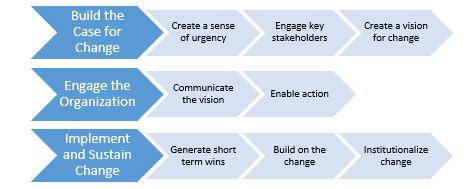Encouraging Change
While the legal industry hasn’t (yet) experienced a major disruptive event that it hasn’t recovered from with its model largely intact, all the forces we see today are what we refer to as being ‘pecked to death by ducks.’ The cumulative effect of these forces is already impacting traditional firms and that impact will continue to grow.
Further, based on research testing personality traits of lawyers it is clear that as a group lawyers tend to be skeptical and risk averse. While these are valuable skills in a legal context, they can also result in a resistance to change. It’s not surprising that partners question the need to change. However, ultimately law firms will be forced to change despite the best efforts of many partners.
So how can leaders break through change resistance and better position the firm for the future? There are some useful lessons to be learned from traditional change management approaches. John Kotter, in his classic book Leading Change, outlined an eight-step approach to change management. These eight steps can be loosely organized into three broad categories:

Some of these steps are intuitive, but others are not. While there is often a temptation to skip one or more steps, each is important. While the scale of each will vary with the size of the project, going about even small changes in a deliberate way will help ensure success and pave the way for future change.
Once a project is identified, key steps include:
- Educate the firm on “why change” is needed. What are the forces demanding change? What happens if the firm doesn’t change? What are the benefits of change? The case for change is strengthened if you can include data and analysis rather than vague concepts or change for change’s sake. The voice of the client can be a critical component here in convincing partners of the need for change, whether through client interview feedback or client panels at retreats or other forums. The “why change” needs to support the specific project, not just the idea of change in general.
- Get key stakeholders on board. There are two groups you will want to focus on – first is the group who came up with a new idea or who will be leading the initiative. Typically, this group should include at least one partner. While it is tempting to delegate to associates and staff, the reality in many firms is that it may be harder for that group to get the buy-in required than a partner led group. The second group is the potential naysayers, particularly those who are regarded as leaders in the firm. This group may require one-on-one attention to bring them along and to make sure they don’t hold back the initiative.
- Articulate the vision for the specific project. It’s important to not only be able to tell lawyers what the project is about, but how it will be executed and what the expected benefits are. It is important to anticipate questions that partners may raise (possibly by testing the concept with skeptical partners in advance).
- Communicate the vision. Use multiple platforms for communication. A single announcement at a partner meeting or via memo is unlikely to resonate with many partners. Take advantage of one on one conversations, written communication, partner meetings, using ambassadors (your key stakeholders for example) and the like. Reinforce the message throughout the process.
- Enable action. In the law firm context enabling action includes not only providing resources, but removing barriers. A pricing initiative, for example, may require software support and resources from the finance team but also requires attention to partner performance metrics to ensure that partner incentives don’t discourage experimenting with new pricing approaches.
- Generate short term wins and build on them. Look for ways to pilot small projects to generate early successes and results.
- Communicate these successes broadly and build on them. At the same time, it is important to be realistic about the impact of new initiatives. The return is more likely to come over the long term with the cumulative impact of multiple changes, so building on early wins is critical to generating ongoing support.
- Institutionalize change. Over time it is important to make the change a regular part of the firm’s operations. The initial team may no longer need to be shepherding the project. The firm will need to evaluate what is required for the project to become a normal business practice.
Just as the changes impacting the legal market are coming in small bites, change in the firm can be taken in small steps. While big projects have the potential to flounder, small successful projects can give the lawyers, and management, confidence. The small projects can expand to bigger projects and can also encourage new ideas.
The profitability of the legal industry is one of the things that makes it attractive to new entrants and a target for disruption. And the reluctance of firms to change creates an opening for some of those new entrants to reinvent the model. Firms who do not examine at least some aspects of their business model are at risk of falling behind over time. Managing change effectively can help create an openness to change that will serve the firm well over the long term.

